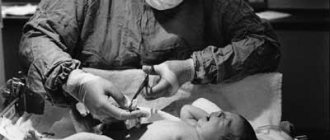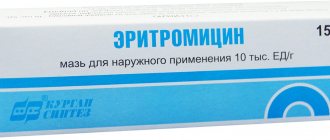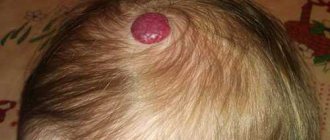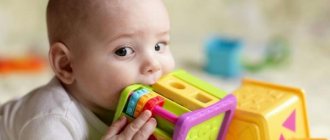Parents often have a negative attitude towards the Shants collar and other orthopedic products. They believe that such splints lead to discomfort for the newborn. Doctors prescribe regular wearing of a collar only for medical reasons. In these cases, it leads to the following positive effects for the child’s body:
- ensures a stable and physiological position of the cervical vertebrae;
- improves blood flow through the cerebral arteries and blood supply to the structures of the central nervous system;
- allows you to relax the neck muscles, which can be spasmed and cause pain;
- The collar provides a micro-massage that affects the nerve endings in the skin of the neck.
These effects have a positive effect on the child’s health. They make it possible to increase the effectiveness of the therapy methods used to treat congenital diseases.
Selecting a tire for a child
The Shants collar can be used at different ages. It is important to know how to choose it. There are 3 main types of product, depending on the strength of fixation: soft, medium and strong fixation. The latter type of splint is rarely used, as it causes discomfort in the child.
Doctors know how to choose the right collar. Therefore, parents need to go to a special salon to purchase an orthopedic device, and not buy the product by hand. When choosing a size, the child's age and weight are taken into account. The collar should be used until the age of one year.
When choosing a Shants collar for newborns, orthopedists recommend purchasing products in the following sizes:
- if the child was born prematurely and is less than one month old, then choose a splint with a length of 28 cm and a width of 2.7 cm;
- if the child was born on time and is less than one month old, then the dimensions of the tire are 32 cm in length and 3.4 cm in width;
- For children under one year old, a collar is 33 cm long and 4 cm wide.
In an orthopedic salon, a specialist helps you try on a collar. The child stays in it for half an hour. If anxiety, crying or other negative phenomena occur, the size of the collar can be changed.
How to dress a newborn?
A collar is often prescribed for torticollis. The attending physician puts it on the child for the first time. He shows the procedure to the parents.
The collar is positioned in such a way that the hollow of the newborn’s chin is located. The splint is secured from the back with Velcro. You should not fasten it tightly - there should be a gap of one finger between the collar and neck. When used correctly, the orthopedic product completely covers the neck, while the cheeks and chin remain open.
The wearing pattern of the Shants collar is determined by the attending physician. It is based on the nature of the existing disease, its severity and the individual characteristics of the child. If parents do not follow it, then the orthopedic splint can lead to negative health consequences.
Orthopedic pillows and collars for torticollis in newborns
Torticollis is often diagnosed in newborns..
Almost 3% of infants face this problem.
To treat pathology, devices are used that help eliminate the disease at an early stage of its development.
Various treatment methods are absolutely painless and do not cause discomfort or inconvenience to the baby.
In addition to gymnastic manipulations and massage, means are used to treat altered skeletal conditions, which completely eliminate the effect on the baby from the outside.
These devices are orthopedic pillows for torticollis and special collars .
What is an orthopedic pillow for torticollis?
An orthopedic pillow for correcting a baby’s torticollis is a device in which the baby’s head is fixed in the correct position necessary for the normal functioning of the cervical spine.
Indications and principle of action
Orthopedic devices for the cervical spine are indicated for children if abnormal development of the cervical spine - torticollis .
With this diagnosis, the position of the baby's head is incorrect: the head is tilted to the side, the chin is directed in the opposite direction. In this case, the baby cannot turn his head in a different direction.
This condition may be due to incorrect position of the head in the womb for a long time, disruption of muscle tissue during the passage of the birth canal, or other factors that are not hereditary.
The orthopedic effect of the fixation pillow for infants is due to the following actions::
- the pillow supports the child’s neck and head in such a way that the load on the muscles is reduced and blood circulation in the cervical region is improved;
- the spine is straightened;
- ensures the formation of a physiologically healthy and correct curvature of the spinal column;
- normalization and restoration of muscle tone in the child’s cervical region occurs.
Using an orthopedic pillow can be effective in correcting abnormal development of a baby's spine. The use of an orthopedic pillow for a baby is aimed at ensuring that the baby lies comfortably, with the correct body position. The use of such pillows is of limited use.
: “Why does a baby need an orthopedic pillow?”
Contraindications
While an orthopedic pillow is a necessary treatment device for torticollis, the use of a pillow is not recommended for a healthy child with normal spinal development without abnormalities.
Some doctors are inclined to argue that a healthy baby does not need a pillow at all : its use can only cause harm and will have an unsatisfactory effect on the formation of the cervical spine.
Important! If a child has a tendency to regurgitate frequently, then the use of an orthopedic pillow is prohibited. Since the baby cannot yet roll over in the first months of life, when he regurgitates, he may choke when the orthopedic pillow fixes his head.
Types of orthopedic pillows
Manufacturers of orthopedic products for the head try to provide maximum comfort when using their products, so they produce pillows for different purposes.
The most common orthopedic pillows are:
| View | What forms does it come in: | Description |
| Pillow headrest |
| This pillow has a small hill in the center, and higher cushions on the sides and top of the head. This way the head is in a fixed position. If the child sleeps on his side, then in this case a cushion is placed under his side for comfort and to relieve tension from the muscles. For torticollis, this is the kind of pillow that doctors recommend for use. |
| Positioner |
| The pillow has a recess in the center and fixing rollers on the sides. This orthopedic device fixes the baby's position during sleep in a certain body position. Most often, such pillows are used to prevent a child from turning over on his back while sleeping. This option is often used in strollers to prevent shocks when the stroller is pushed sharply. It is especially important to use such a pillow for children who frequently spit up. |
| Inclined | It comes in the shape of a low trapezoid. | This pillow allows the baby to be completely laid down on it, with the body positioned at an angle (the head is higher, the lower part of the body is lower). Sometimes clamps are used on such pillows to prevent the baby from sliding down during sleep. |
In addition, depending on the purpose, orthopedic pillows are:
- for swimming;
- for use in a stroller;
- with body position memory.
All of them from each manufacturer can be of different shapes, sizes, and can be made in the form of soft toys - animals, with elements of ears, tails, eyes, paws.
Important! Before using an orthopedic pillow, you should consult your doctor to determine the advisability of its use. In order not to harm the baby, the orthopedic device should be used correctly.
Method of using pillows
The use of an orthopedic pillow should be described in the attached instructions. If there is such a thing, we can say that the manufacturer cares about the buyer, and in addition, inspires confidence in the quality of the product.
Methods of using pillows differ depending on their shapes:
- the headrest is used in such a way that the thinnest and narrowest cushion is located under the baby’s neck, and the thickest one is located above the baby’s head;
- the positioner assumes the placement of a larger roller - towards the child's side, and a small one - under the head;
- When using an inclined pillow, the baby is placed on the higher part with her head. Most often, on such pillows, the baby sleeps on his side;
- The swimming pillow is placed around the neck so that the cushion is on the side of the neck, and the open part is located in front, without covering the baby’s throat.
Important! Sleeping pillows should be used in such a way that the cushion does not interfere with the baby’s free breathing and does not create an uncomfortable position for the child’s body. With torticollis, it is especially important that the load on the muscular frame of the baby’s neck is reduced and the spine is fixed in the correct position.
Trench collar for torticollis
The trench collar for torticollis helps to fix the position of the child’s vertebrae, and also reduces the load on the cervical spine.
The trench collar is a device that encircles the neck with Velcro , which adjusts the length of the collar depending on the size of the neck circumference.
The material used to make the collar is flexible medical polyurethane foam, which is protected in a soft cover.
At the same time, the elasticity of the device and softness are ensured. There are soft, semi-soft and hard collars.
The latter are not covered with a soft cover, but are a plastic frame with Velcro.
Indications
The chance collar is suitable for both adults and newborn children.
The multifunctionality of the collar allows it to be used for the following pathologies:
- hyperexcitability;
- complications of the nervous system during difficult childbirth or pathological pregnancy;
- short neck syndrome;
- postpartum cranial injury in a newborn due to rapid or too long labor;
- development of torticollis in newborns.
Important! Only a specialized specialist can prescribe wearing a trench collar. Using a collar on your own can significantly weaken muscles and impair functional development.
Mode of application
Trench collars must come with wearing instructions.
The collar should be worn on a bare neck . The degree of tightening should be such that the collar should not interfere with free breathing and swallowing. The freedom of fixation of the collar is determined by the thickness of the adult finger: it must pass freely between the baby’s neck and the retainer. The chin should rest against a special notch for it.
The time to wear the collar should be determined by a doctor. The only inconvenience when wearing a collar is difficulty in feeding , since the collar restricts the downward movement of the jaw.
Recommendations for selection
Orthopedic devices must be prescribed by a doctor. The orthopedist will also be able to advise you to purchase the right form of orthopedic brace, depending on the course of the disease.
However, the following requirements must be met for all fixing devices::
- the material used in the manufacture of the frame must be hypoallergenic;
- an orthopedic pillow must have good air permeability to prevent the occurrence of prickly heat in infants;
- The orthopedic pillow should keep its shape well. Devices that are too soft can make the situation worse.
The choice should, first of all, not be based on the external attractiveness of an orthopedic pillow for babies (its brightness and attractiveness), but on its quality characteristics.
: “How to choose a pillow for a child?”
Regular wearing
It is important for parents to know how long the Shants collar is worn. If the pathology is congenital, then the orthopedic product is used during the first month of the child’s life. It is important to understand that the amount of time with a splint during the day can vary significantly - from 10 minutes to round-the-clock use. This depends on the nature of the pathology and its severity.
After a month, parents re-visit the orthopedist, neurologist and other specialists, depending on the disease. They evaluate the newborn's condition and, if necessary, advise continued use of the Shants collar.
Negative consequences
If parents do not know how to wear a collar for a newborn and self-medicate, complications may arise for the child. These include the following conditions:
- if the collar is over-tensioned, it begins to compress the neck and trachea area, leading to breathing problems. As a result, the child begins to experience hypoxia and the functioning of the cardiovascular system changes;
- With prolonged use of the splint, hypo- and atrophy of the neck muscles occurs. In the absence of load, their volume decreases, which can lead to the progression of the underlying disease. At the age of two months, children can hold their heads well and the collar should only be used for a short time.
The use of homemade devices is prohibited. Tires must be manufactured in accordance with existing standards and from materials approved for use for newborns.
The Shants collar in newborns is an important part of the treatment of congenital neck pathologies. It allows you to fix it in a physiological position and prevent the further development of diseases. In therapy using a splint, it is important to choose the right one in consultation with an orthopedist. The doctor will choose the collar size, explain how to put it on, and outline a wearing pattern for the first weeks of treatment. If the child is constantly restless or there are external signs of soft tissue compression by the splint, parents should immediately consult a doctor.
In case of torticollis or birth injuries, the Shants collar for newborns allows you to stop and correct developmental features in a short time.
After a difficult birth, newborns may experience birth trauma, which is characterized by persistently incorrect head position, curvature of the neck muscles, and disorders of the central nervous system. The same disorders can be caused by pathologies of pregnancy.
Video about indications for using a splint collar
During difficult, protracted labor there are complications.
Moreover, in frequent cases, injury to the cervical spine of a newborn is observed during the delivery process.
In such cases, the neonatologist prescribes an orthopedic collar called the “Schants collar” to the newly born baby.
It is prescribed when it is necessary to limit movement in the neck area for a certain period of time, fixing it in a favorable physiological position.
Watch a video with the participation of a neurologist, in which he describes in detail the reasons and indications for which it is necessary to use a special orthopedic splint - the Shants collar
Dear doctor! I have a question for you. I have a kitten with suspected displacement of the vertebrae in the cervical spine, can he be given such a collar? A kitten is as precious as a child. I couldn’t find any information on veterinary websites, so I’m writing to you. I sincerely hope that you will give me your invaluable time and attention and answer!
We suggest you read: Causes of treatment and recovery after a fracture of the metacarpal bone
During difficult births, the child is often born with injuries, and the cervical spine is most often affected. If a problem is detected, the neonatologist may advise putting a Shants collar on the newborn. There is nothing wrong with this, you just need to know a few simple rules for choosing and wearing.
You cannot independently determine the need to wear an orthopedic collar. The purchase and use of a Shants collar for a newborn child is carried out only after a doctor’s prescription. The doctor determines the duration of wearing the collar during the day and the duration of the course of treatment.
When purchasing, you must take into account the child’s parameters. To do this, measurements are taken from him. An incorrectly fitted orthopedic device can cause harm to the child. For example, the neck muscles may weaken, and the child will begin to hold his head up later than others.
The product must be kept clean. It can be washed, but only by hand, avoiding exposure to high temperatures. You cannot refuse your doctor’s recommendations on using the Shants collar on your own. This can cause negative consequences for the child's health.
What are the benefits of orthopedic slippers for the home Orthopedic slippers for children Where to buy? Leg fatigue, swelling [...]
What is the base for an orthopedic mattress? Base for a single bed Base for a mattress for two […]
Indications for use Common pathologies Characteristics of shoes Choosing shoes Shoes are of great importance for the health of the musculoskeletal [...]
The information on the site is provided for informational purposes only, does not claim medical accuracy and is not a guide to action. Do not self-medicate. Consult your healthcare provider. The use of materials from the site is prohibited.
All rules and nuances of regular use of the product must be discussed with the attending physician. He also prescribes the duration of treatment and the time of daily wearing of the splint. This can be from 10 minutes to 24 hours a day for weeks, months, six months and even longer. Typically, a collar is put on a baby after a wellness massage or performing physical therapy exercises. Only in combination with additional manipulations will the effect of wearing the device be quick and pronounced.
When putting on a collar, you need to remember the following points:
- The cutout of the tire should be at the top, located under the chin.
- The clasp of the product is fixed at the back, the child should not reach it.
- To check that the collar is positioned correctly, try to insert your finger between it and the baby's neck. The distance should be about 1-1.5 cm.
- It is strictly forbidden to move the collar. It is initially applied to the baby’s neck correctly and simply fastened at the back. If the product has moved, it must be unfastened, returned to the desired position and fastened.
A correctly worn collar does not interfere with the child and does not cause skin irritation. If redness appears on the neck under the product, the device is removed and not put on until everything has healed. You must notify your doctor about this. The structure is removed for bathing. It should not be used like an inflatable ring!
Attention! Copying site materials is possible only with the permission of the administration and with an active link to the source.
The information is provided for informational purposes only. Self-medication can lead to undesirable consequences! At the first sign of disease, consult a doctor.
How to develop the most significant areas for a child in minutes a day
✐ Three ready-made scenarios for comprehensive developmental classes in pdf format;
✐ Video recommendations on how to conduct complex games and how to compile them yourself;
✐ A plan for creating such activities at home.
Indications for wearing a Shants collar
Various pathologies of intrauterine development, manifested in the formation of the skeleton, are diagnosed in the first weeks of life. If the pediatrician notices certain disturbances in the development of the child, he prescribes the newborn to wear a Shants collar. What is it and why is it needed?
Technically, this is a simple fixation that allows you to relieve the sore spot, relieve tension from the muscles and vertebrae, transferring the weight of the head to an artificial structure. The purpose of such a device is to correct the condition of the cervical vertebrae, which allows blood circulation to return to the physiological norm and creates conditions for the proper development of the child.
The collar (collar, as mothers often call it) fixes the child’s head and neck in the correct position, and constant warmth eliminates discomfort from muscle tension.
The doctor prescribes the use of the Shants collar to correct the following conditions:
- Diagnosed postpartum cranial injury, which arose as a result of rapid labor, high weight of the baby, as a result of injuries received during too fast or too long labor. In these cases, the orthopedic collar is immediately put on by neonatologists present at the birth;
- Manifestations of brain dysfunction as a consequence of birth trauma. The pediatrician notes excessive lethargy, weak muscle tone, and immature reflexes. Diagnosis of the condition is noted by a pediatric neurologist in the first weeks of life, the collar is prescribed and put on by the doctor;
- Excessive excitability after birth trauma or due to developmental disorders. It manifests itself in excessive excitability, the child screams sharply, arches, his face turns red, his hands and chin tremble;
- Torticollis and movement disorder syndrome;
- In case of congenital pathology of the development of the cervical spine or injury to this department during obstetrics (short neck condition).
The use of a Shants splint relieves the spine and restores normal cerebral blood flow. Only a specialized doctor can prescribe a Shants collar for correction. You need to wear it as long as necessary to treat the pathology, as prescribed - otherwise the neck muscles will become too weak and will not correspond to the physiological norm for development - the child will not hold his head up in a timely manner.
Putting on a Shants splint on your own without consulting a doctor is prohibited.
What is a Shants collar for newborns?
The design is a fixator, the task of which is to reduce the load on the cervical spine.
The device provides optimal conditions for the restoration of damaged tissue. The soft frame prevents excessive neck rotation and flexion. Regular use of the Shants collar for newborns normalizes muscle tone and improves blood flow in the injured area. The Shants orthopedic collar is nothing more than an ordinary fixator of the cervical spinal column, which helps relieve stress. It is a piece of foam rubber that has Velcro or fasteners at the ends. Thanks to them, the device is fixed around the baby’s neck in the form of a collar.
The main indications for using a collar are:
- Birth injuries with damage to the cervical spine.
- Torticollis in a newborn.
- Pathologies of the nervous system that provoke neurological pain in the cervical region.
- Myositis.
- Short neck in a newborn.
An orthopedic collar is also indicated for traumatic brain injuries (for example, concussion), although such cases are quite rare in newborns and infants.
The Shants collar for newborns is a kind of fixing device that relieves stress from the cervical vertebrae of a newborn. Due to this support, the basic functions of the spinal column are restored faster. Parents of young patients who are prescribed such a fixative are concerned about various things.
The Shants collar is a circle made of foam rubber material, at the ends of which there are Velcro strips that help adjust the diameter of the collar. This clamp also has another name - splint. It performs an important therapeutic function: it brings the vertebrae of the cervical spine to their normal position. This is necessary because only in the right state is sufficient blood circulation created, which allows the baby to feel comfortable and, accordingly, contributes to its healthy development.
Cases when neonatologists recommend that parents purchase a Shants collar for newborns are not so uncommon. This is not a reason to panic, although it is not the most pleasant start to a baby’s life.
The main thing is to strictly follow the specialist’s recommendations and take maximum responsibility when choosing a device and its use. The operation process itself is not as complicated as it seems. And if you don’t miss any nuances, the baby will soon recover and you can discard the functional device.
The Shants collar is a special device designed to fix the cervical spine in order to relieve stress from the neck. As a result of such rest, the department is restored, leveled, stretched, and lost or blurred functions return to it. Most often, the product is prescribed to children who have been injured during a protracted labor.
In addition, the collar may be indicated for children with the following diagnoses:
- Any movement disorders.
- Malfunctions of the central nervous system.
- Complications during pregnancy or childbirth.
- Short neck syndrome.
- Torticollis.
- Increased excitability of various etiologies.
- Violations of head position, leading to compression of nerve endings and blood vessels in the neck.
In all of the above cases, it is necessary to fix the neck in a special position, and the Shants collar ideally meets this requirement. It is a foam rubber circle with Velcro to secure it in the desired position. The product has a soft surface and curved shapes. Despite the apparent harmlessness of the design, only a doctor can prescribe its use.
The Shants collar is just a fixator for the cervical spine. It is needed in order to relieve this part of the body and create comfortable conditions for restoring damaged functions. The Shants collar, which doctors call a splint and mothers call a collar, actually plays an important role in therapeutic measures aimed at normalizing the cervical spine.
The Shants collar is a splint made of soft foam rubber, covered with cotton fabric, with a recess for the chin in the center and Velcro at the ends, which act as a volume regulator for the orthopedic bandage. The device is prescribed for:
- torticollis;
- violation of motor functions of the neck;
- short neck syndrome.
It is no less effective if the child experiences central nervous system depression caused by difficult pregnancy, childbirth, or when the baby is extremely active.
The collar is designed to fix the cervical vertebrae in a certain position. Wearing it helps:
- unloading the muscles of the cervical spine;
- improving blood flow to the brain;
- correct neck position.
The Shants collar has the effect of dry heat and micromassage. With its help, you can slightly stretch the newborn’s neck.
Wearing an orthopedic device may be recommended not only during the newborn period, but also during the first 6 months of life, and sometimes even a year.
Shants splint for torticollis
Sometimes the baby holds his head noticeably incorrectly and his neck is bent to one side. This problem can occur in both boys and girls, and is most often congenital. Acquired torticollis occurs due to inflammatory processes.
The first manifestations of impaired development of the cervical muscles will either be noticeable after childbirth or may appear during the first weeks.
The mother's observation and knowledge of the symptoms of torticollis will help identify the pathology. The first thing that begins to catch your eye is that the child’s head will be tilted to the side - this reveals right-sided or left-sided torticollis.
Some babies have a short neck, and torticollis is indicated by a constant tilt of the baby's head to one side; the baby's eyes and the tips of the earlobes are on the same straight line. With age, tension in the facial muscles (one-sided) will be noticeable.
During the massage, the mother or specialist will be able to feel the excessive tension in the muscle, which feels like a tightness. There are several other types of congenital torticollis:
- Sprengel's disease;
- a short neck, in which the head rotates heavily; the child only squints his eyes at the sound, unable to turn his head. The chin rests directly on the chest, and the hair grows low on the back of the head.
If short neck syndrome is not diagnosed in a timely manner and treatment is not undertaken, the child does not hold his head up for a long time.
The main cause of the condition is considered to be trauma during childbirth and hemorrhage. The connective tissue that has developed in this place tightens the muscle, preventing it from developing properly. As a result, insufficient muscle development (mainly the sternoclavicular muscle) is formed.
A doctor can diagnose positional torticollis in a newborn - the simplest form of pathology, the cause of which is considered to be the incorrect position of the child in the crib.
Shants' orthopedic collar holds the child's head in the correct position and allows the muscle to develop correctly. For treatment, the doctor additionally prescribes physiotherapeutic procedures.
Shants collar for newborns - salvation for the baby
Childbirth, both easy and complicated, is a colossal burden on the child’s body. It happens that a baby is born with injuries. The most common of them is damage to the cervical spine. The causes of injury may be the structural features of the mother's pelvis, the weight and size of the fetus, prematurity, prolonged or very rapid labor, as well as incorrect behavior of the woman in labor at the time of birth of the head.
In this case, the neonatologist prescribes a Shants collar to the newborn (the device was named after its inventor, Alfred Shants). This orthopedic collar, also called a splint, looks like a collar - a soft, wavy, elastic circle. It is based on medical foam rubber or porous-synthetic material, which is covered with a permanent cotton cover. The top of the collar is covered with washable fabric.
We wore it from 3 to 6 months. There was a result.
The child developed neurological problems due to rapid labor, and we were prescribed a Shants collar. We wore it almost without taking it off, and after a month we noticed the first improvements.
The Shants collar for newborns was prescribed to us by a doctor in the maternity hospital due to injuries during childbirth. Since the baby was born weighing 5700 kg, for obvious reasons the birth (natural) was not easy. As a result, the baby has a dislocated shoulder, swelling in the neck and cephalohematoma. To relieve swelling in the neck and reduce the load on the spine, we were prescribed a Shants collar and put it on in the first hours immediately after birth.
The doctor prescribed us to wear the collar without taking it off for 1 month. Of course, I wanted to take it off earlier. It has one BIG MINUS - it interferes with feeding. It is difficult for the baby to open her mouth under the pressure of the collar and it is difficult for her to fully latch onto the nipple, so in the first month we had a breastfeeding battle, which we won.
The Shants collar can restore the baby’s health if the rules for its use are followed. Prescribing a splint is the sole prerogative of the doctor. After studying the child’s condition, he decides what type and size of collar to wear and for how long. He will also introduce the mother to the features of caring for the device and tell her how to care for the skin on the child’s neck.
Childbirth, both easy and complicated, is a colossal burden on the child’s body. It happens that a baby is born with injuries. The most common of them is damage to the cervical spine.
We invite you to familiarize yourself with: Bubnovsky’s exercises for the spine at home: gymnastics for the back and joints
The causes of injury may be the structural features of the mother's pelvis, the weight and size of the fetus, prematurity, prolonged or very rapid labor, as well as incorrect behavior of the woman in labor at the time of birth of the head.
In this case, the neonatologist prescribes a Shants collar to the newborn (the device was named after its inventor, Alfred Shants).
This orthopedic collar, also called a splint, looks like a collar - a soft, wavy, elastic circle.
It is based on medical foam rubber or porous-synthetic material, which is covered with a permanent cotton cover. The top of the collar is covered with washable fabric.
The Shants collar effectively relieves torticollis
When the cervical spine is injured, many health problems arise for the baby. The child is lethargic, weak, and has almost no reflexes.
The limbs and chin often tremble. The baby lets out a piercing cry, throws his head back - he is in pain.
An orthopedic product is prescribed if the doctor observes:
- short neck syndrome;
- torticollis;
- hyperexcitability;
- neurological disorders due to trauma to the cervical spine;
- movement disorders;
- depressed central nervous system.
Wearing a collar without indication has a negative impact on the functioning of the child’s muscular corset: when receiving support, the muscles relax and atrophy.
When a neonatologist prescribes wearing a splint for a newborn, a young mother often has doubts: she is afraid that the child will be scared or uncomfortable, that the collar will harm him.
Probably, excessive anxiety is explained by the condition of a woman who has just given birth. In fact, the Shants collar has a number of positive effects on the newborn’s body.
As a result of wearing a splint, the following occurs:
- The vertebrae of the cervical area acquire a normal position.
- Blood circulation to the brain improves.
- Proper development of the baby is ensured.
- The neuromuscular system is normalized. The affected muscles relax and recover.
- The warming effect reduces pain.
- The tire has micromassage properties.
- Healthy sleep is ensured, so the child can sleep without removing the collar.
Types of collars
- rigid fixation;
- medium hardness;
- soft.
Rules for selecting a Shants collar
Only a doctor can prescribe wearing a splint; he will also tell you how to choose the size of the splint you need and how to put it on.
Shants collars are bought in orthopedic salons; in difficult cases, craftsmen make the required collar according to the child’s measurements according to the doctor’s instructions, using the sizes selected by him (with a versatile splint for torticollis).
The main dimensions for choosing an orthopedic collar are the distance from the baby’s collarbone to the angle of the lower jaw and the volume of the neck.
A mismatched splint size for a newborn is unacceptable - a splint that is too large will not give the desired effect, and a splint that is too small will not allow the child to breathe properly.
Shants collar: varieties
There are retainers for adults and for children. Osteochondrosis of the cervical spine, migraines, subluxations of the upper vertebrae are the main indications for wearing a collar for adults. He can be:
- soft;
- with rigid fixation;
- medium hard.
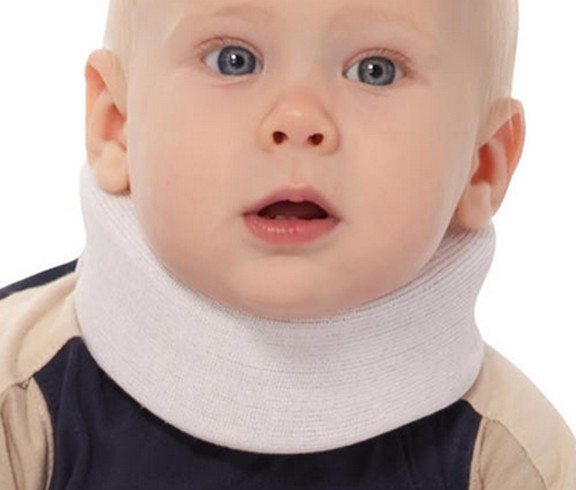
In most cases, it is recommended to wear a soft retainer.
The choice of a retainer for a small child must be approached responsibly. Before purchasing a splint, measure the distance between the lower jaw and the angle of its middle part. For newborns, the ideal height is three to five centimeters.
A collar that is too short will pull to the side, and a collar that is too long will not serve its purpose. And, as a result, the treatment will be ineffective, on the contrary, it will bring even more problems.
What is the tire made of?
The cervical collar consists of an elastic base (special medical polyurethane sewn into a non-removable cover) and a washable fabric on top. The cover is made of cotton, it is easy to wash and does not act as an allergen.
There is an adjustable fastener at the back that allows you to adjust the size when putting on the collar; if worn for a long time, the splint will definitely need to be changed as the child grows.
Children's and adult collars serve similar purposes (unloading and fixation), but are made of different materials; the collar for adults is stiffer.
The children's collar is elastic and soft in the hands, when compressed it restores its shape, there is Velcro at the end of the collar, which makes it quick and easy to put on the Shants collar.
Putting on an orthopedic collar
As the instructions prescribe, the design should be worn directly on the body; the collar should not interfere with breathing or, conversely, be pulled to one side. It may be intended for continuous use; it may be prescribed to be worn at night, or for several hours during the day. A properly dressed cover should fasten loosely at the back, with the chin resting against a special recess on the collar. The mother's finger should fit between the baby's neck and the cover.
A doctor should show parents how to properly put on a splint for the first time.
Problems that may arise for parents after putting it on for constant wearing are difficulties with feeding (the child will have difficulty opening his mouth).
Types of collars, their features
There are several types of neck brace for newborns. The most common type of bandage is soft. According to the instructions, the corset has the following features:
- Has a slight warming effect;
- Allows the child to easily move his head in all directions, while gently supporting the neck muscles;
- Relieves muscle pain and tension;
- Has a relaxing effect.
This variety is made of foam rubber. There are other types of collars - medium hard and hard.
The medium-hard collar has a plastic insert inside. When worn constantly, it improves blood circulation, strengthens the cervical spine, and helps consolidate the effect of the massage.
The rigid insert is made of plastic. It is used for scoliosis, as well as after operations. For convenience, the product is equipped with a special recess, which is located under the child’s jaw. There is also additional support at the rear.
For minor dysfunctions of the cervical spine, a mild option is usually sufficient for successful correction. It is the cheapest and is most often prescribed by orthopedists to correct torticollis.
Tire care
The orthopedic collar should always be clean; this is important for infants who do not yet know how to eat carefully, and saliva may flow onto the collar.
Throughout the day, the fabric of the cover can be cleaned with damp sanitary napkins, hand washed in warm water using a neutral detergent, and dried flat.
The use of automatic washing machines and dryers is not recommended for caring for orthopedic structures.
Photo from the site tksd.net.ru
Long-term fixation of the neck using the Chance collar over time leads to stabilization of the muscular-ligamentous system and returns the spine to its normal state. In newborns and infants, the bandage is used only as prescribed by a doctor and under his supervision.
Indications
Indications for wearing a Shants collar by newborns:
The Shants gate is used in the complex therapy of premature and weakened children who are unable to hold their head up, to correct neurological symptoms due to craniocervical trauma. The combination of polyurethane foam with an anatomical shape promotes uniform distribution of pressure on the points of support without injuring or compressing them.
Prescribing the Shants splint to newborns is possible as a rehabilitation aid after surgery on the upper cervical spine or to preserve the results of manual treatment.
Description of the Shants collar for a child
It is important to know! Doctors are shocked: “An effective and affordable remedy for joint pain exists...” Read more...
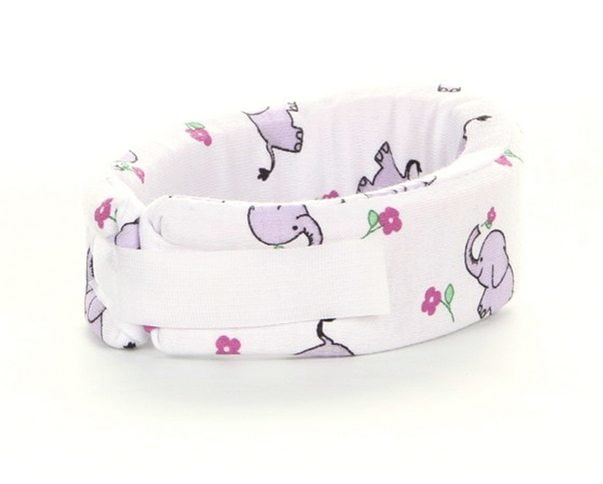
The Shants children's collar is a fixator for the cervical spine, helping to eliminate the load on the neck and normalize the functioning of this area. There is a collar for both children and adults.
The Shants collar for a child plays a huge role in improving the functioning of the neck and normalizing blood flow to the brain. The product provides favorable conditions for further proper development.
The orthopedic collar is made of foam rubber and equipped with Velcro on both sides, thanks to which you can adjust the volume of the device. Outwardly, it is similar to a collar. A specialist is responsible for prescribing the splint, since muscle atrophy develops if chosen and used incorrectly. In this case, due to weak muscles, by two months the baby will not be able to hold his head. You can wear the collar for up to a year.
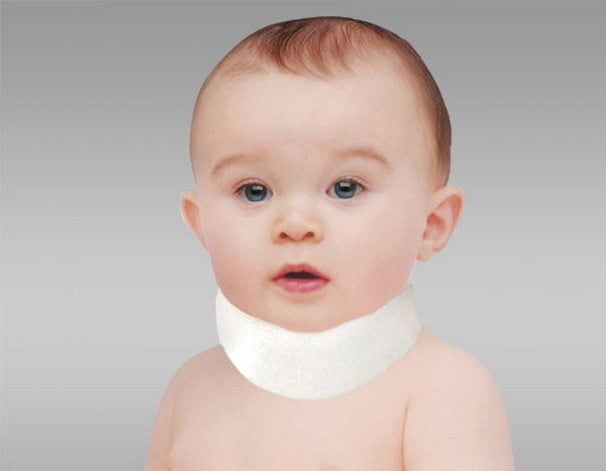
Types of bandages for newborns
The main criterion when prescribing a Shants collar to a newborn is the degree of fixation, which depends on the material and design features of the product. Today, orthopedic companies offer many children's orthoses with different levels of rigidity and indications for use.
The most common type of bandage in pediatrics. It is an elastic foam splint covered with fabric with a recess for the chin and a strong clasp. It has a thickness of 2–3 cm.
Prescribed to premature and weak babies immediately after birth to correct minor changes in the cervical spine caused by difficult childbirth.
Elastic and soft Shants splint for newborns:
- allows limited movement of the head without disturbing the position of the vertebrae;
- corrects mild torticollis;
- warms, relaxes muscles and relieves pain.
The foam collar is comfortable to wear, does not cause discomfort and does not interfere with the newborn’s exploration of the world. The baby gets used to the orthosis and stops noticing it.
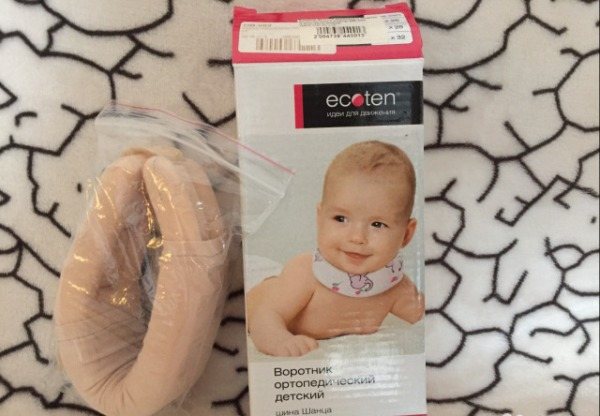
Photo from festima.ru
For more serious injuries to the cervical spine - dislocations, cracks or small fractures, the baby requires fixation of medium rigidity. This can be provided by a Shants collar made of polyurethane foam with a plastic insert. This brace gives a stable position to the head and stretches the spine well.
In addition, on sale you can find a Shants collar model F-300 for moderate fixation of the cervical region, made of foam rubber. Thanks to its original design, the splint improves blood circulation in the affected area, relieves stress on the vertebrae and muscular system, and consolidates the results of manual correction.
The Shants collar of the German brand Orlett BN6-53 is recognized as the most convenient and effective of the medium-fixation bandages. Made from high-strength polyurethane, the orthosis helps to correct serious disorders after birth trauma, vacuum extraction, and rotational subluxation.
Rigid structures for newborns are made of soft plastic or thermoplastic polyethylene foam. Collars have a submandibular notch and posterior support, and can be equipped with an opening for a tracheostomy.
Types of orthopedic splints
They are worn the same way, despite the fact that they are different in appearance and size.
There are the following types of Shants collars:
- orthopedic collar with rigid fixation;
- orthopedic collar of medium hardness;
- soft orthopedic collar.
It is made from medical foam rubber or porous synthetic material. Has elastic-elastic properties. The top is covered with fabric and sometimes comes with a protective cover.
Contraindications to wearing a Shants collar include severe instability in the cervical spine and various dermatological diseases.
There are three types of Shants collars: hard, medium and soft fixation. In pediatrics, the latter option is usually used, but exceptions may occur. When purchasing the desired model, you need to check that it is made of porous synthetic raw materials or medical foam rubber, which is covered with fabric on top and has an elastic, elastic texture. Products often come with a protective case, but this is not necessary.
Advice: Despite the fact that today you can find master classes on the Internet on how to independently design such collars, resorting to this approach is highly not recommended. The slightest miscalculation in the work or the use of the wrong material can not only have no effect, but also harm the baby.
We suggest you read: How to get rid of dizziness with cervical osteochondrosis
It is important to understand that the Shants collar for newborns must be selected strictly according to size. Although babies look similar, differences in weight and neck length can be significant. The height of the model for a newborn is usually from 3 to 5 cm. It is better to entrust the measurements to an orthopedist or consultant in a specialized store.
When selecting, preference is given to the material that will contribute to the best therapeutic effect depending on the problem.
Soft collar
After a mild injury and with cervical myositis, a cervical bandage made of soft material is indicated. The foam splint is porous and elastic to ensure comfortable wearing. Externally, it is a wide strip, in which there is a recess designed for a comfortable position of the chin. The Shants collar is securely fixed using Velcro.
The orthopedic children's design allows the child to tilt the head to a limited extent, strengthens the vertebrae and prevents the formation of osteochondrosis.
The design of the presented type of tire does not differ from a soft tire. For this reason, it is important to know what the Schanz semi-rigid collar is for. The product provides a tight fit to the neck and limits rotation in the cervical spine. The dense material has metal inserts.
When worn every day, infants experience discomfort due to the manufacturing features. The fixator provides good traction and is often prescribed for cervical hernia in both children and adults. Parents are always interested in how long to wear a collar made of semi-rigid material. The duration of treatment usually does not exceed 1 month.
Hard collar
The metal structure is intended for severe damage. The main indication is a fracture in the cervical spine. The bandage immovably fixes the spine of a month-old baby in a certain position. Complete immobilization creates conditions for the restoration of damaged tissue.
Most often, doctors recommend using the third type, since it causes the least discomfort and allows the child’s muscular system to develop thanks to non-rigid fixation.
Soft collar
How to choose the size?
A Shants collar for a newborn is purchased taking into account the child’s parameters. To avoid mistakes, you can make an individual order or take your own measurements and buy a ready-made bandage from them in a specialized store.
To select an orthosis, you need to know the girth and height of the child’s neck. The first indicator is determined at the base of the neck, the second is measured from the collarbone to the angle of the lower jaw.
Shants collar size chart
| To whom is it assigned? | Neck circumference, cm | Neck height, cm |
| Premature babies (first month of life) | 28 | 3 |
| Newborn babies (from 1 to 28 days) | 32 | 3,5 |
| Children under 1 year | 33–35 | 4 |
If the product turns out to be larger or smaller than the baby’s neck, then it will not be of any use. If the collar slips to one side or the child's soul, it will do more harm than correct the shortcomings.
Shants collar price
Approximate tire prices:
- collar with semi-rigid fixation for an adult - 220 rubles;
- collar for children up to one year 5N6-53 - 300 rubles;
- device with rigid fixation - 990 rubles;
- orthopedic splint for children OV-003, OV-004 - 250 rubles;
- orthopedic neck bandage A310 - 200 rubles;
- neck brace for newborns F300 - 200 rubles;
- neck brace with high back part ORTEX 015 - 1400 rubles.
The Shants collar for newborns, the cost of which will depend on the manufacturer, material, size, is an effective remedy that helps cure pathologies, in particular torticollis.
Despite the difficulties in caring for a baby when using a bandage, the positive therapeutic effect significantly prevails. Most parents do not follow the recommendations for using a therapeutic collar, or, even worse, refuse to wear it, limiting the baby to massage procedures only.
Improper treatment of cervical diseases can subsequently cause the development of serious complications - chronic neck pain, further progression of torticollis and impaired blood supply to the brain.
Self-medication and the use of homemade devices are strictly not recommended. Remember: only a qualified specialist can select the correct device.
Similar articles
How to put on a Shants collar correctly and how long to wear it?
The neck brace for newborns is placed directly on a clean, dry neck or a soft cotton pad is used.
To do everything correctly, you can use the process description below:
- Place the splint on the baby's neck so that the notch is directly under the chin.
- Wrap the collar around your neck and secure at the back with a clasp.
- Check the tightness of the orthosis.
How long should you wear a Shants collar? It all depends on the complexity of the case - for some, the doctor recommends not removing the orthosis for 4-5 hours in a row, while other children spend 24 hours a day in it. The specific period is determined only by the doctor.
Under no circumstances should you limit wearing a collar on your own. If the specialist has not prescribed anything else, the bandage is removed only for the duration of massage, bathing or hygienic treatment of the skin.
Yes, you are allowed to sleep in Shants' collar. If a newborn is prescribed to wear a bandage around the clock, then it should be removed only when necessary. In addition, it is advisable for your baby to purchase an orthopedic pillow - it will help maintain the anatomically correct position of the vertebrae of the cervical segment during sleep.
How to put on a Shants collar correctly
The best option is to get a personal consultation with an orthopedic doctor or a specialist in an orthopedic salon.
But if this is not possible, follow these rules:
- Carefully inspect the collar; it should have a special recess intended for the chin;
- Velcro is attached only to the back;
- If the bandage is too tight, breathing will be difficult, and if it is too loose, it will not be of any use.
- It must be fixed in such a way that an adult’s finger can easily fit between the collar and the baby’s neck.
How much to wear
Only an orthopedic doctor can determine for what period of time a Shants collar needs to be worn.
If the pathology is congenital
This bandage is put on immediately after childbirth, the period of wearing it in this case is one month, it can only be removed during bathing. Therefore, you should dress your baby in such a way that the clothes do not put pressure on the collar and cause discomfort to the baby.
If the defect is due to other reasons
Worn for several hours a day. If the baby is prescribed a massage course, then the Shants collar is put on after the session.
Hygiene while wearing a collar
To avoid inflammation and irritation in the neck area, the skin there should be constantly clean and dry. When soiled, the product can and should be washed in cool water, by hand; it must be dried flat, otherwise deformation is possible.
Product care
In order for the Shantz children's collar to last a long time and bring benefits, it should be properly cared for:
- hand wash only in warm water using a mild detergent;
- dry flat on a horizontal surface away from radiators and heating devices;
- Machine wringing, ironing and the use of chemical cleaners is prohibited.
If the product comes with a removable cover, then it is better to wash only that. Polyurethane foam dries very poorly, and the child may be left without a bandage for a long time.
The orthosis requires careful and careful handling. It is recommended to store it in a dry place at room temperature, avoiding direct sunlight and dust. The product must not be wrinkled, bent or folded, otherwise it will lose its shape and become useless.
Contraindications for use
There are no special restrictions on the use of the Shants collar for infants. It is not recommended to wear a bandage only in case of damage to the skin on the neck (wounds, scratching, various allergies and eczema). The use of an orthosis in this case will lead to an exacerbation of the pathological condition.
If the baby does not feel very well in the bandage, shows anxiety, cries and is capricious, it is better to remove the device and contact a pediatric neurologist. Perhaps the size is incorrect or the child really cannot wear the collar. The doctor will decide what to do in this case.
Cost of a bandage for newborns
The price of an orthopedic neck brace depends on the manufacturer’s brand, material and design complexity. The average cost of products in Russia as of the end of 2020 is shown in the table.
Shants collar price table
| Orthosis brand | Fixation degree | Price |
| ORTO TV-000 | soft | 270 rub. |
| Fosta F 9001 | soft | 235 rub. |
| Trives, height 3.5 cm | average | 200 rub. |
| Trives, height 4 cm | average | 250 rub. |
| bandage F-301 | average | 143 rub. |
| ORLETT BN6-53 | average | 460 rub. |
| Bandage Philadelphia, Trives | strong | 1670 rub. |
You should buy an orthosis for children under 1 year of age at an orthopedic store. Only a high-quality product can provide a decent therapeutic effect and will not harm the baby.
The Shants collar is an effective and safe device for the treatment of torticollis and birth injuries in newborns. The bandage is used only as prescribed by a doctor and is worn for the recommended period. You cannot remove it ahead of time or replace it with another model without the permission of a specialist.


